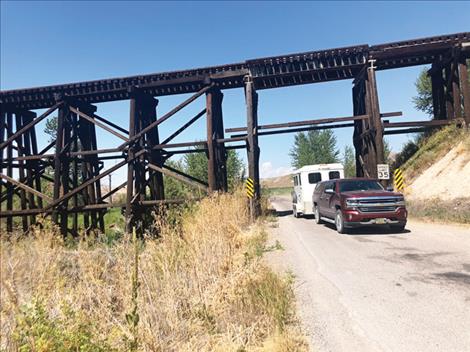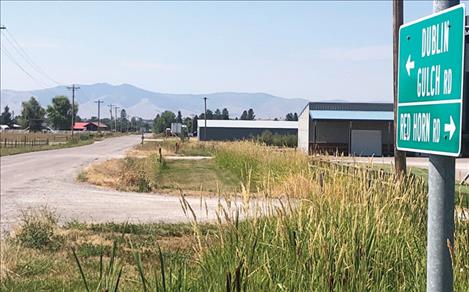RAISE grant to rebuild county roads
Hey savvy news reader! Thanks for choosing local.
You are now reading
1 of 3 free articles.
LAKE COUNTY — Officials learned last week that Lake County will receive nearly $13 million from the U.S. Department of Transportation to fully rebuild three critical stretches of road over the next few years.
The $12.9 million Rebuilding American Infrastructure with Sustainability and Equity (RAISE) grant – one of four awarded statewide – will finance rebuilding and paving projects on Dublin Gulch Rd., a short section of Moiese Valley Rd. and North Reservoir Rd., which will also get a bike/pedestrian lane. All three roads provide important links to state highways, offer alternative routes during traffic disruption along the Hwy. 93 corridor, and are essential for ferrying commercial and agricultural products and services.
Lake County road supervisor Jay Garrick calls the grant “a boon for everybody that has to use those roads and a huge win for the county. It’ll save us tens of thousands of dollars annually in just maintenance costs on those roads.”
The county’s grant manager, Billie Lee, who authored and will oversee the grant, also wrote the $10 million TIGER grant nearly a decade ago that rebuilt Skyline Drive, with an adjacent walking/bike path. This time around, she says, the focus was on connectivity.
The Mission Valley has a dearth of paved roads connecting its two major north-south thoroughfares, Highways 93 and 212, which bring commerce, supplies and tourists to and through the county.
“This valley is unique because Hwy. 93 is the only route between Missoula and Kalispell,” says Lee. If that corridor is blocked due to road construction or a major accident, there are few ways to reroute traffic, especially semi-trucks that can’t easily navigate gravel roads with sharp turns along section lines. Commerce, tourism and local travel are all vulnerable to such disruptions.
According to the grant application, the roads that will be rebuilt and paved are considered “primary connectors that transport goods and services within, to and from the area, as well as transporting people to work, school and communities and are critical to supporting the basic economies of the county and Flathead Reservation.”
Like many roads in Lake County, these three were originally built on layers of native soil, covered with gravel, and eventually chip sealed due to high use.
The value of Dublin Gulch Rd. as an east-west connector was uncomfortably apparent in 2019, when the road through the gulch was washed out and closed for eight months, forcing those who regularly use the route to cut between Hwy. 212 and U.S. 93 to take cumbersome detours.
In his letter of support for the project, Jerome Stenberg of Stone Mountain Builders, whose business and family’s ranch are located on Dublin Gulch, says the narrow, uneven road surface is “not just dangerous, but extremely dangerous.”
Amy Vaughan, whose family also lives on Dublin Gulch, says there have been two traffic fatalities and four vehicles have landed in the ditch in front of her house.
“As a primary access point to the west side of the Mission Valley and the town of Charlo, Dublin Gulch sees a wide variety of traffic for such a narrow, uneven paved road,” she writes. “On any given day, semi-trucks, commuter cars, school buses, and bicyclers use this road. Often, there are challenges when any of these interact with another.”
The 5.5-mile road, especially through the Post Creek drainage, is plagued by spring flooding. In addition to widening and paving the thoroughfare, the project will replace 20 undersized, inadequate culverts and span Post Creek with a bridge.
North Reservoir Road, a 3.66-mile corridor that connects Hwy. 93 to Back Road (State Highway 354), has one of the top five highest traffic counts in Lake County. Many of those vehicles are heavy commercial trucks headed to or from the transfer station or nearby gravel and cement plants, or carrying agricultural goods, including grain and seed potatoes.
Mark Nelson, manager of Lake County’s Solid Waste District, notes that in 2021 more than 103,000 vehicles entered the transfer station through its gate on Reservoir Road. The eroding road surface and potholes are hazardous to drivers and punishing to vehicles, he reports.
On a personal note, Nelson applauds the addition of a bike lane connecting the bike/pedestrian path along Hwy. 93 to Back Road – a route already popular with cyclists. A bike rider himself, he writes “the current status of the road creates very hazardous conditions whenever it is shared by a large truck and a cyclist.”
The entrance to Moiese Valley Road, just north of the Bison Range, is also slated for improvements. The first mile travels beneath an unused railroad trestle and across wetlands managed by the Confederated Salish and Kootenai Tribes before heading uphill into the valley, which is home to myriad farms, ranches and ag-related businesses. The valley has just two access points, 13 miles apart, so when that portion of the roadway floods, locals are forced to travel 10 to 13 miles north, then an additional 12 miles to access U.S. 93, or further to return to Hwy. 212.
Linda Ludeman of Moiese Fertilizer Company says any closure of the entrance to the Moiese Valley would seriously impact the business, which serves farmers across the Mission Valley. The company receives more than a dozen tractor-trailer loads of raw materials each week and delivers an average of 10 loads of fertilizer a day. In addition, her family farm ships around 50 tractor-trailers filled with wheat each year.
A road closure at the south end of the valley would force her to slow or cease deliveries entirely since the only other route “is a narrow dirt road with a very steep grade” and a bridge with a load limit considerably under the weight of most shipments.
Vern and Barbie Stipe, who also live, ranch and run a trucking business in the Moiese Valley, say a road closure could cause major disruptions to their livelihoods and impact their ability to access medical care in Missoula. Barbie, they note, works as a rural route carrier in Arlee six days a week, and has no substitute driver.
“We rely on Lower Moiese Valley Road every day, and, by extension Dublin Gulch,” they write.
The RAISE funding is especially welcome in a county with a small property tax base and perennial budget constraints. The $12.9 million grant is more than five times the county’s annual road budget of $2.5 million, which pays for materials, equipment and labor for patching, snow removal, weed and dust control, and grading on more than 1,400 miles of roads, a third of which are gravel. In contrast, Missoula County spends around $6 million yearly and Flathead County over $9 million to maintain fewer miles.
“We do the best we can with what we’ve got,” says Garrick.
“An influx of more than $12 million dollars is significant,” adds county commission Gale Decker. “Setting aside dollars to rebuild any one of these three roads has been impossible for the county to accomplish.”
According to Garrick, asphalt costs more than $150,000 mile, which doesn’t include the expense of hauling materials and prepping and covering the road bed with the much more durable surface. Chip seal, on the other hand, costs $53,000 per mile.
“We can’t begin to do a project like this with our existing budget,” he says. “We’re barely able to do enough chip seal to try to keep up.”
The nearly 10 miles of high-traffic arterials covered by the grant absorb up to three times the average amount budgeted per mile due to damage from flooding, freezing and thawing, and heavy use. An added benefit to the project is that once the roads are reconstructed, the cost of maintaining them will be minimal, allowing the county to channel those funds to other areas.
Work on the three projects is slated to begin in 2024 and be completed in 2025. While the reconstruction will cause temporary disruptions for people who use the roads regularly, “the end result will be well worth it,” says Garrick. “We were due for a win here in Lake County and I feel like we finally got one.”

















